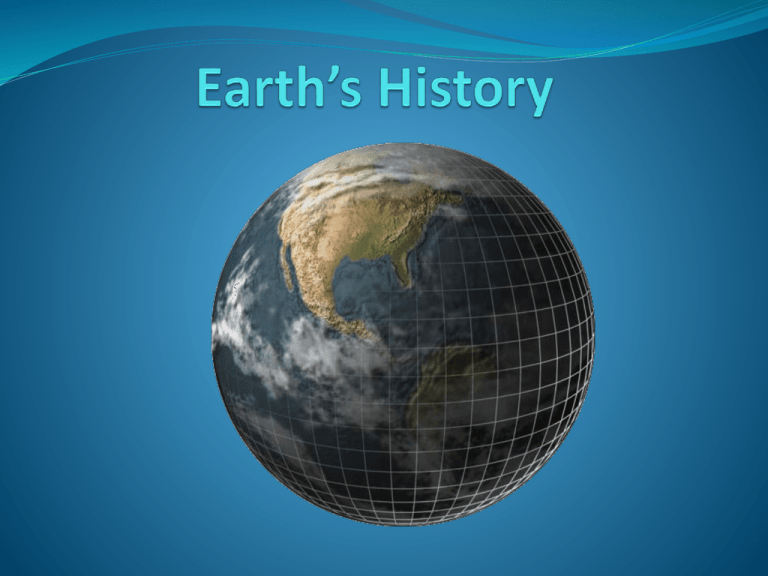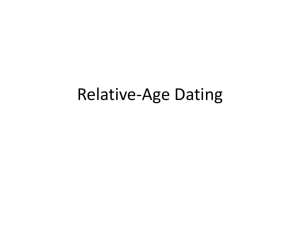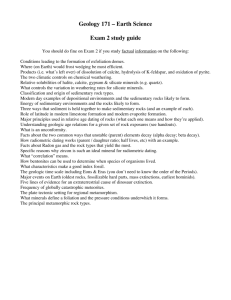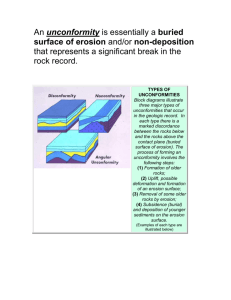Earth's History
advertisement

Discovering Earth’s History In the 18th and 19th centuries scientists knew the Earth had a very long history. They developed a Geologic Time Scale that showed the sequence, or order of events based on several principles of relative dating. Rocks record geological events and changing life forms of the past. Erosion has removed much of the Earth’s rock record, but enough still remains to allow a lot of Earth’s history to be interpreted. The geologic time scale revolutionized the way people think about time and how they perceive our planet. Rocks Record Earth History We have learned that Earth is much older than anyone had previously imagined and that its surface and interior have been changed by the same geological processes that continue today. The primary goal of geologists is to interpret Earth’s history. By studying rocks, especially sedimentary rocks, the geologists can begin to put the pieces together. In the mid-1600/s Archbishop James Ussher constructed a timeline for both Earth and human history. He determined that the Earth was created in 4004 B.C. In the 1700’s James Hutton published the Theory of the Earth. Ussher Hutton A Brief History of Geology In Hutton’s work he introduced this fundamental principle: Uniformitarianism: the forces and processes that we observe today have been at work for a very long time. (plates moving, rain, wind, etc) Today, Scientists understand that these same processes may not always have had the same relative importance or operated at the same rate. Some important geologic processes aren’t currently observable, but evidence that they occur is well established, for example meteorites. Relative Dating—Key Principles Relative dating tells us the sequence in which events occurred, not how long ago they occurred. There are 3 observations in which Nicolaus Steno, a Danish scientist and priest, is credited with describing a set of geologic observations that are the basis of Relative dating. 1st Law Law of Superposition -in an undeformed sequence of sedimentary rocks, each bed is older than the one above it and younger than the one below it. Grand Canyon Relative Dating—2nd Law Principle of Original Horizontality • layers of sediment are generally deposited in a horizontal position. Relative Dating—3rd Law Principle of Cross-Cutting Relationships • when a fault cuts through rock layers, or when magma intrudes other rocks and crystallizes, the fault or intrusion is younger than the rocks affected. Applying Cross-Cutting Relationships Youngest Event Layer 4 Layer 3 Layer 2 Dike B Layer 1 Oldest Event Fault A Relative Dating—Key Principles Inclusions • Inclusions are rocks contained within other rocks. • Rocks containing inclusions are younger than the inclusions they contain. Formation of Inclusions Relative Dating—Key Principles Unconformities • represents a long period during which deposition stopped, erosion removed previously formed rocks, and then deposition resumed. •There recognition helps us identify what intervals of time are not represented in the rock record. 3 different kinds of unconformities An angular unconformity indicates that during the pause in deposition, a period of deformation (folding or tilting) and erosion occurred. Formation of an Angular Conformity Relative Dating—Key Principles Unconformities • A disconformity is when two sedimentary rock layers are separated by an erosional surface. A nonconformity is when the erosional surface separates older metamorphic or intrusive igneous rocks from younger sedimentary rocks. A Record of Uplift, Erosion, and Deposition Correlation of Rock Layers Correlation is establishing the equivalence of rocks of similar age in different areas.







